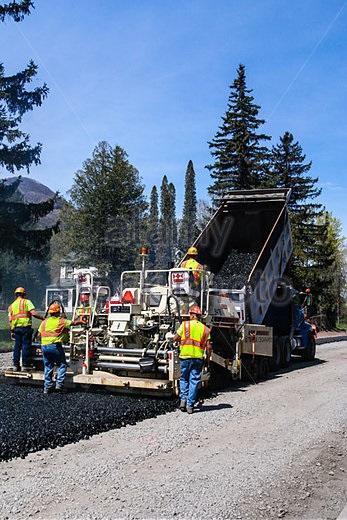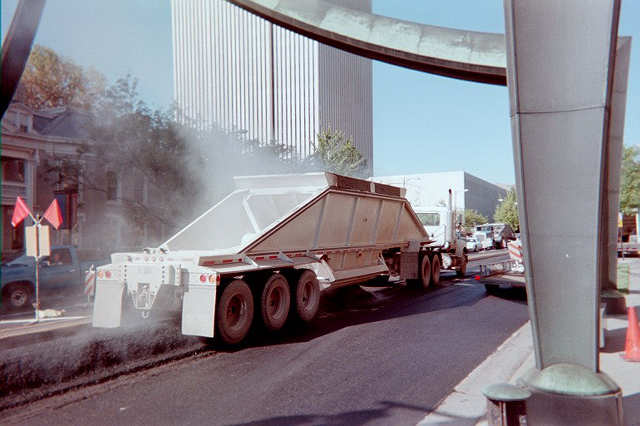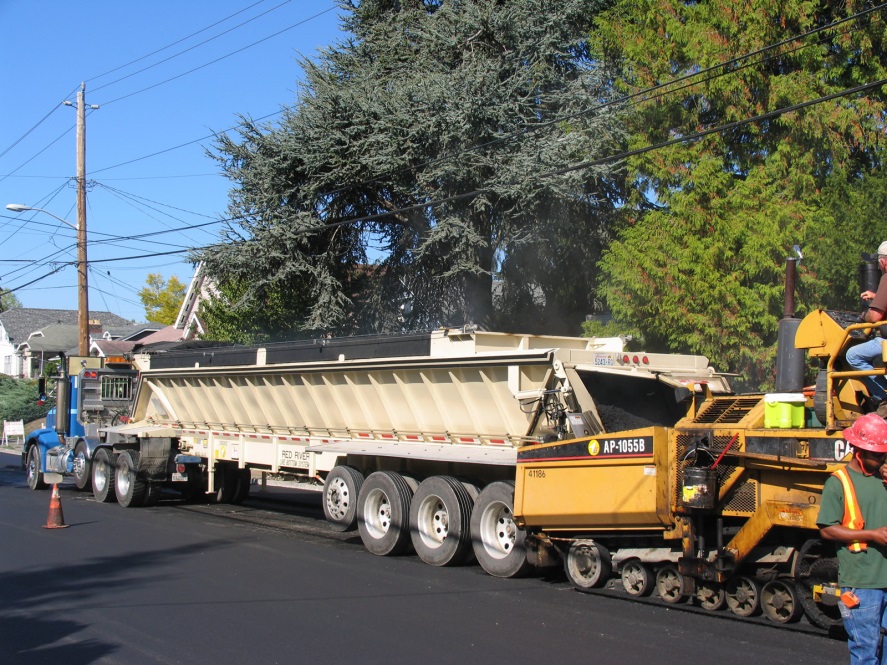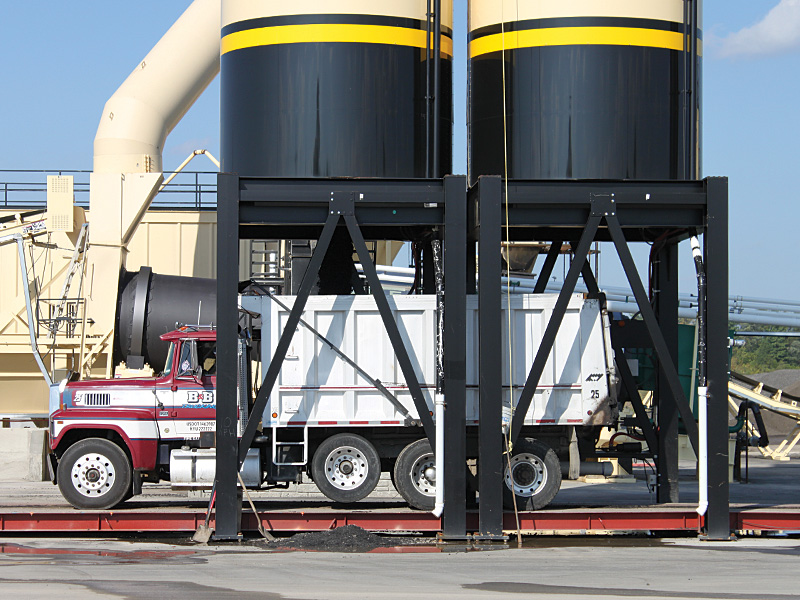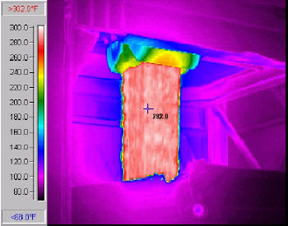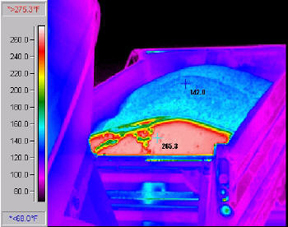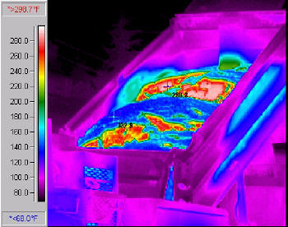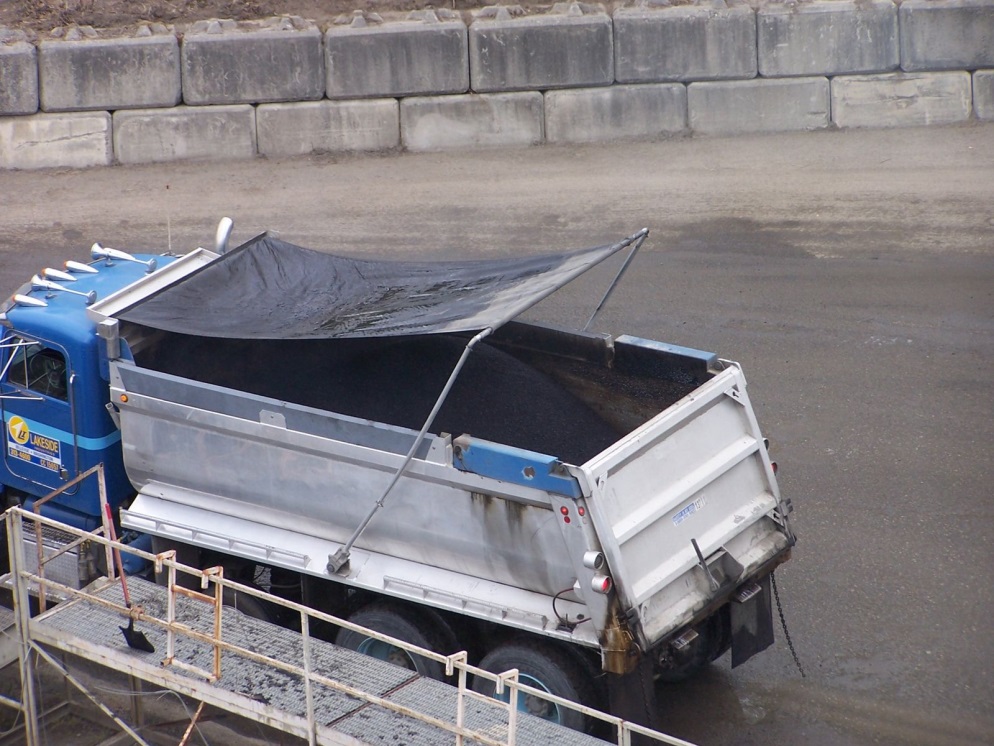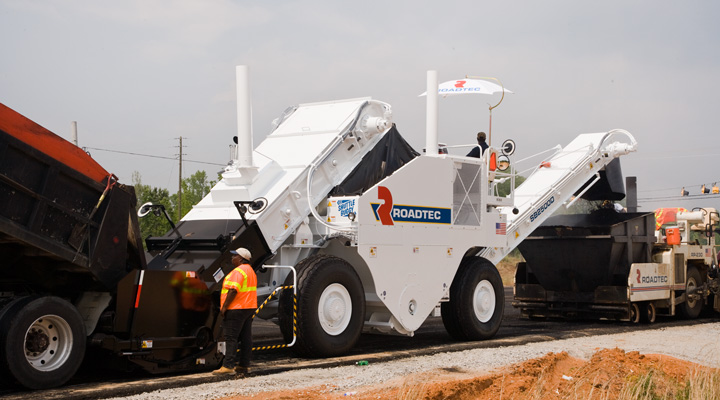Section 6: Mix Transport
Anchor: #i10283766.1 Introduction
Mix transport involves all actions and equipment required to convey HMA from a production facility to a paving site, including truck loading, weighing and ticketing, hauling to the paving site, dumping of the mix into the paver, windrow, or material transfer vehicle hopper, and truck return to the HMA production facility (Roberts et al., 1996). Ideally, the goal of mix transport should be to maintain mix characteristics between the production facility and the paving site. Transport practices can have a profound effect on mix temperature at the paving site, aggregate and/or temperature segregation of the mix, and mat quality. This section will discuss the types of trucks used for mix transport and the various considerations involved with mix transport.
Anchor: #i10284376.2 Truck Types
There are three basic truck types used for mix transport classified by their respective HMA discharge methods:
- Anchor: #OTWJAXDR
- end dump, Anchor: #HNKNFJNX
- bottom dump (or belly dump), Anchor: #WJSARMAD
- live bottom (or flo-boy).
6.2.1 End Dump Truck
End dump trucks unload their payload by raising the front end and letting the payload slide down the bottom of the bed and out the back through the tailgate (see Figure 6-13). End dump trucks are the most popular transport vehicle type because they are plentiful, maneuverable, and versatile. Some general considerations associated with end dump trucks are:
- Anchor: #STSYMBMY
- When the bed is raised, it should not contact the paver. Bed contact with the paver may affect the screed tow point elevation, which can affect mat smoothness. Anchor: #JKTTJMKI
- The truck bed should be raised slightly before the tailgate is opened. This allows the HMA to slide back against the tailgate, which will cause it to flood into the paver hopper when the tailgate is opened. HMA that trickles into the paver hopper is more susceptible to aggregate segregation. Anchor: #JJEGYSFB
- Truck-paver contact should be established by allowing the paver to move forward into a stationary truck. This ensures that the truck does not bump the paver too hard and cause the paver to lurch to a sudden stop, which could cause a rough spot in the mat. Anchor: #XKKDLBUB
- Once the paver and truck are in contact, they should remain in contact. This ensures that no HMA is accidentally spilled in front of the paver because of a gap between the truck and paver. Usually, the truck driver will apply the truck’s brakes hard enough to offer some resistance to the paver but light enough so as not to cause the paver tracks to slip from excessive resistance. Most pavers can also be coupled to an unloading truck using truck hitches located on or near the push rollers.
Figure 6-13. End Dump Truck.
6.2.2 Bottom Dump Truck
Bottom (or belly) dump trucks (see Figure 6-14) unload their payload by opening gates on the bottom of the bed. Internal bed walls are sloped to direct the entire payload out through the opened gates. Discharge rates can be controlled by the degree of gate opening and the speed of the truck during discharge. The discharge is usually placed in an elongated pile, called a windrow (see Figure 6-15), in front of the paver by driving the truck forward during discharge.
A windrow elevator is used to pick up HMA from the windrow and feed it into the paver hopper. Windrow elevators do not have any method of regulating material flow, which makes it necessary to place the correct amount of HMA in the windrow to match the paving width and depth being placed without allowing the paver hopper to run out of mix or become overloaded.
Figure 6-14. Bottom dump truck. © Copyright 2006 University of Washington
Figure 6-15. Windrow made by emptying a bottom dump truck. © Copyright 2006 University of Washington
6.2.3 Live Bottom Dump Truck
Live bottom (or flo-boy) dump trucks (see Figure 6-16) have a conveyor system at the bottom of their bed to unload their payload. HMA is discharged out the back of the bed without raising the bed. Live bottom trucks are more expensive to use and maintain because of the conveyor system, but they also can reduce segregation problems (because the HMA is moved in a large mass) and can eliminate potential truck bed – paver contact (because the bed is not raised during discharge).
Figure 6-16. Live Bottom Truck. © Copyright 2006 University of Washington
Each truck type is capable of adequately delivering HMA from a production facility to a paving site. However, certain situations, such as the ones listed in “Table 6-2: Truck Type Advantages” below, may make one truck type advantageous over another.
|
Situation |
Possible Truck Type |
Reason |
|---|---|---|
|
Paving on congested city streets |
End Dump |
Better maneuverability because it has no trailer and is smaller than a bottom dump or live bottom truck. |
|
Paving using a mix highly vulnerable to segregation |
Live Bottom (Flo Boy) |
Live bottom trucks deliver the HMA by conveyor, which minimizes segregation. |
|
Paving on rural highways |
Bottom Dump (Belly Dump) |
Usually has a larger capacity than end dump trucks (therefore fewer trucks are needed), but requires space and equipment for windrows. |
Anchor: #i1029023
6.3 Operational Considerations
There are several mix transport considerations, or best practices, that are essential to maintaining HMA characteristics between the production facility and the paving site. These considerations can generally be placed into four categories:
- Anchor: #TMHJJVPE
- loading at the production facility, Anchor: #WJLKDWJS
- transport within the truck, Anchor: #YJFISOCG
- unloading at the paving site, Anchor: #OVBYUCTJ
- operation synchronization.
6.3.1 Loading at the Production Facility
Loading at the production facility involves transferring HMA from the storage silo or batcher (for batch plants) to the transport truck. There are two potential issues with this transfer:
- Anchor: #IHTQGJHX
- Truck bed cleanliness and lubrication. Truck beds should be clean and lubricated to prevent the introduction of foreign substances into the HMA and to prevent the HMA from sticking to the truck bed. Non-petroleum based products should be used for lubrication, such as lime water, soapy water, or other suitable commercial products (Roberts et al., 1996). (The product should come from TxDOT’s list of approved release agents.) Petroleum based products, such as diesel fuel, should not be used because of environmental issues and because they tend to break down the asphalt binder. Anchor: #NWNLWQQQ
- Aggregate segregation. HMA should be discharged into the truck bed so as to minimize segregation. Dropping HMA from the storage silo or batcher (for batch plants) in one large mass creates a single pile of HMA in the truck bed (see Figure 6-17). Large-sized aggregate tends to roll off this pile and collect around the base. Dropping HMA in several smaller masses (three is typical) at different points in the truck bed will largely prevent the collection of large aggregate in one area and thus minimize aggregate segregation.
Figure 6-17. Truck loading under a storage silo. © Copyright 2006 University of Washington
6.3.2 Truck Transport
Truck transport affects HMA characteristics through cooling. HMA is usually loaded into a truck at a fairly uniform temperature between 250 to 350°F (see Figure 6-18). During transport, heat is transferred to the surrounding environment by convection and radiation, and the HMA surface temperature drops. This cooler HMA surface insulates the interior mass and thus transported HMA tends to develop a cool thin crust on the surface that surrounds a much hotter core (see Figure 6-19 and Figure 6-20). Factors such as air temperature, rain, wind, and length of haul can affect the characteristics and temperature of this crust. Several measures that can be taken to minimize HMA cooling during transport are:
- Anchor: #JPCHIRUO
- Minimize haul distance. This can be accomplished by choosing an HMA production facility as close as possible to the paving site. Closer production facilities create shorter haul times and result in less HMA cooling during transport. Unfortunately, many paving locations may not be near any existing production facilities, and economics or environmental concerns may prohibit the use of a mobile production facility. Anchor: #JTGOXJET
- Insulate truck beds. This can decrease HMA heat loss during transport. Insulation as simple as a sheet of plywood has been used. Anchor: #KWBUMSLB
- Place a tarpaulin over the truck bed. A tarp over the truck bed (see Figure 6-21) provides additional insulation, protects the HMA from rain, and decreases heat loss. A study by the Quality Improvement Committee of the National Asphalt Pavement Association (NAPA) studied truck tarping and found that the HMA surface temperatures of tarped loads dropped more slowly than untarped loads, but temperatures 100 mm (4 in.) below the surface between tarped and untarped loads were not significantly different (Minor, 1980).
Figure 6-18. Infrared picture of an HMA storage silo loading a truck showing the hot uniform temperature of the mix. © Copyright 2006 University of Washington
Figure 6-19. Infrared picture of a truck dumping HMA showing the cold surface layer crust (blue) and the hot inner mass (red). © Copyright 2006 University of Washington
Figure 6-20. Infrared picture of a truck dumping HMA showing the cold surface layer crust (blue) and the hot inner mass (red). © Copyright 2006 University of Washington
Figure 6-21. Tarped Truck. © Copyright 2006 University of Washington
In most cases, truck transport appears to cool only the surface of the transported HMA mass; however, this cool surface crust can have detrimental effects on overall mat quality if not properly dealt with. Actions such as reducing transport time, insulating truck beds, or tarping trucks can decrease HMA surface cooling rate. Additionally, since the majority of the HMA mass is still at or near its original temperature at loading, mixing the crust and interior mass together at the paving site (“remixing”) will produce a uniform mix near the original temperature at loading.
6.3.3 Unloading at the Paving Site
HMA unloading involves those procedures discussed in 'End Dump Truck' under 6.2 Truck Types as well as a few other basic considerations, such as:
- Anchor: #AEVFGTKS
- HMA should be unloaded quickly when it arrives at the paving site. This will minimize mix cooling before it is placed. Anchor: #AWQVJDRS
- Before HMA is loaded into the paver, material transfer vehicle, or dropped in a windrow, the inspector and/or foreman should be certain it is the correct mix. Occasionally, paving jobs require several different mix designs (i.e., one for the leveling course and one for the wearing course), and these mixes should not be interchanged. Anchor: #OGNLUYJN
- A material transfer device/vehicle with remixing capability should be considered when mixture type or placement circumstances lend themselves to mixture mechanical or temperature segregation, or a surge volume may be desired to assist in continuous paving operations (see Operation Synchronization below) when the transport truck delivery schedule cannot be ensured (see Figure 6-22). However, considerations must be made to ensure sufficient pavement structure is in place to support some of these larger devices. See Section 6, Material Transfer Vehicles, for additional information.
Figure 6-22. Material Transfer Vehicle with surge capacity (Courtesy Roadtec).
6.3.4 Operation Synchronization
Ideally, HMA production at the plant, truck transport, and laydown at the paving machine should be synchronized to the same rate to minimize accumulation of excess HMA in any one of the three segments. Realistically, however, this synchronization can be quite difficult because of varying laydown rates, unpredictable truck travel times and variable plant production. Detailed information on operation synchronization can be found in:
National Asphalt Pavement Association (NAPA). 1996. Balancing Production Rates in Hot Mix Asphalt Operations, IS 120. National Asphalt Pavement Association. Lanham, MD.
Ideally, all operations are designed to meet optimal mat laydown rates. However, these rates can vary based on paving width and lift thickness. Also, complicated paving locations such as intersections or near manholes and utility vaults can temporarily increase or decrease the laydown rate.
Truck transport should be planned such that the HMA transport rate (expressed in tons/hr.) closely matches plant production rate and laydown rate. Some factors to consider are:
- Anchor: #TXJGGYTF
- number of trucks to be used, Anchor: #BMKSOUOU
- truck type, Anchor: #EDLKGBPV
- average truck hauling capacity, Anchor: #TDNILBVB
- production facility output rate, Anchor: #DASKRDKQ
- availability and condition of storage silos at the production facility, Anchor: #BEDJMXXH
- time to lubricate the truck bed before transport, Anchor: #OHLNEOWI
- waiting time at the production facility, Anchor: #ECVWHWFK
- loading, weighing, and ticketing time at the production facility, Anchor: #JQFXTEDY
- time to cover the load, Anchor: #WGPXXLUQ
- distance between the production facility and the paving site, Anchor: #FVFEFMTX
- average truck speed.
Traffic plays a large role in HMA delivery rates because it affects truck speed. Especially in congested urban areas, heavy and/or unpredictable traffic may substantially increase, or at least vary, truck travel time. As truck travel time increases, more trucks are needed to provide a given HMA delivery rate. Therefore, as traffic gets worse, trucking costs increase. Additionally, the unpredictability of traffic may result in either long paver idle times as it waits for the next truckload of HMA or large truck backups as several trucks all reach the paving site or production facility at the same time.
Finally, production facility output is typically controlled to match haul or laydown rate. However, this can result in suboptimal plant efficiency or HMA uniformity, which may increase plant exhaust output, shorten emission control device lifetimes, and affect contractual payment if payment is tied to HMA uniformity. It may often be more economical to run the production facility at maximum rate and store excess material in storage silos for discharge into trucks as they arrive.
Synchronization should be the goal, but it is often difficult to achieve (based on varying laydown rates, haul time, and traffic) and may result in plant inefficiency and HMA quality degradation. If a production facility has modern, well-insulated, airtight storage silos and is producing a dense-graded HMA, it may be beneficial to run the plant at maximum production rate and store the mix until needed rather than try and match haul or laydown rate.
Anchor: #i10298736.4 Summary
Mix transport can have a large impact on flexible pavement construction quality and efficiency. Mix characteristics such as laydown temperature, aggregate segregation, and temperature differentials are largely determined by transport practices. In general, there are three types of HMA transport trucks: the end dump, bottom (belly) dump, and live bottom dump (flo-boy). End dump trucks are most common; however, bottom dumps and live bottom dumps are well-suited for certain situations. Key considerations in mix transport are:
- Anchor: #YLBJWJPA
- truck bed cleanliness and lubrication, Anchor: #CKWGNJFJ
- proper mix loading techniques in order to prevent aggregate segregation, Anchor: #XWLFNIXQ
- haul distance and mix temperature, Anchor: #KJPSRBYW
- timely mix unloading and unloading of the correct mix.
If properly managed, mix transport can successfully move HMA from the production facility to the paving site with little or no change in mix characteristics. Material transfer devices/vehicles can assist in re-establishing mixture uniformity on site.
